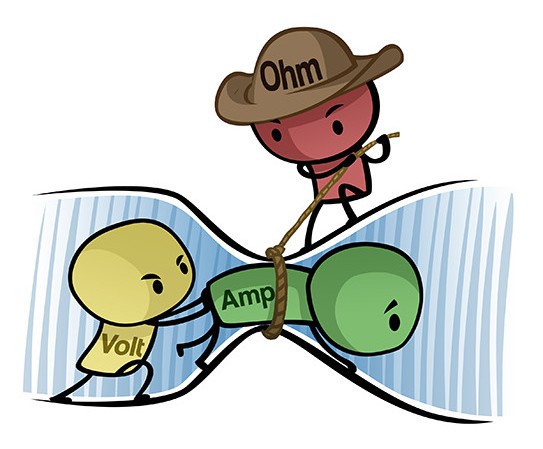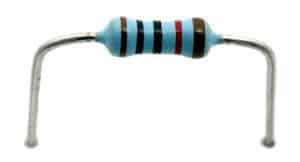Electric current is what you get when electric charge moves around a circuit. It’s pretty simple when you finally get it. But there are some common pitfalls that can give you the wrong idea when learning.
And if you don’t know what current is and how it works, it’s a huge source of confusion when learning electronics.

My goal is that after reading this article, you’ll understand what current is. And you’ll understand that a resistor must have the same amount of current going into it as going out from it.
The Current in a River Metaphor
Electric current is the movement of electric charge. It’s not the charge itself.

As a metaphor, you can think of a river. If a lot of water moves past a point in the river, it means the current is strong. If the water stands almost still, it means the current is weak.
(And if there’s no current at all, it doesn’t mean there’s no water, it just means that the water doesn’t move.)
The circles in the animation below represent electric charge. The current isn’t the circles, but the speed of the circles.
So if you look at the speed of the circles at any point, you’ll find the current at that point.
(I’ll touch upon the direction of current a bit further down.)

Electric Current Isn’t “Used up”
The battery’s voltage is what pushes the charges around the circuit. And here’s an extremely important fact:
A circuit is always completely filled with electric charges. Even when there’s no battery connected.
But when there’s no battery connected, they’re not moving – so there’s no current. But they are still there.
At the moment you connect the battery, the charges start flowing. And what’s very important to notice is that they start flowing in the whole circuit – not just at the start.
So you’ll have current everywhere in the circuit at the moment you connect the battery.

The battery always receives back what it pushes out. One charge pushed out of the plus terminal means one charge is pulled back in from the minus terminal.
That means that the current flowing out of the battery is exactly the same as the current flowing back into the battery.
Current is never “used up”.
How The Resistor Reduces Current
Let’s have a look at what this means for the resistor.

The resistor will “resist” the current. Meaning that it will slow down the charges flowing through it.
But since the circuit is completely filled with charges, that means the charges are slowed down in the whole circuit.
Just like when you squeeze a garden hose so that less water flows out of it. The water is slowed down in the whole hose, not just after the spot you squeeze.
So the current before the resistor is equal to the current after the resistor.
This means that in the case of using a resistor to protect an LED – it doesn’t matter if you place it before or after the LED. In both of the circuits below, the resistor protects the LED:

Electric Charges Don’t Accumulate Anywhere
Sometimes after explaining the above two circuits, I get this question:
“But Oyvind, what about in the beginning when you connect the battery? Before the charges have accumulated in the resistor, surely the LED will get a high current at first, right?”
No. The charges never accumulate anywhere in the circuit.
Remember that the circuit is always completely filled with charges. One charge pushed in means one charge pushed out.
This means that the current flowing out of the battery is the same as the current flowing into the battery, also at the exact moment you connect the battery.
The Direction of Current
In the animations above, the current flows from plus to minus. But you might have come across information saying the opposite – that current really flows from minus to plus. What’s correct?

Electrons flow the opposite way, from minus to plus. Electrons carry a negative charge and are the particles that usually move inside wires.
But current isn’t defined as the flow of electrons. It’s defined as the flow of charge.
The electron carries a charge. But there are other particles that carry charge in a circuit too. For example electron holes that move from plus to minus. And they can both exist in the same circuit.
Electrons are the most common particle that flow in an electric circuit. So shouldn’t we say the current flows from minus to plus?
Well, you can. But remember that electrons carry a negative charge. So you’ll end up with a negative current. Which is fine. You’ll get the same results as us who prefer the plus to minus direction.
Just know that in the world of electronics, an electric current of -20 mA flowing from minus to plus is the exact same thing as a current of +20 mA flowing from plus to minus.

Questions
After reading this, is it clear to you what electric current is? Do you have any questions? Let me know in the comment field below!
Copyright Build Electronic Circuits
No comments:
Post a Comment